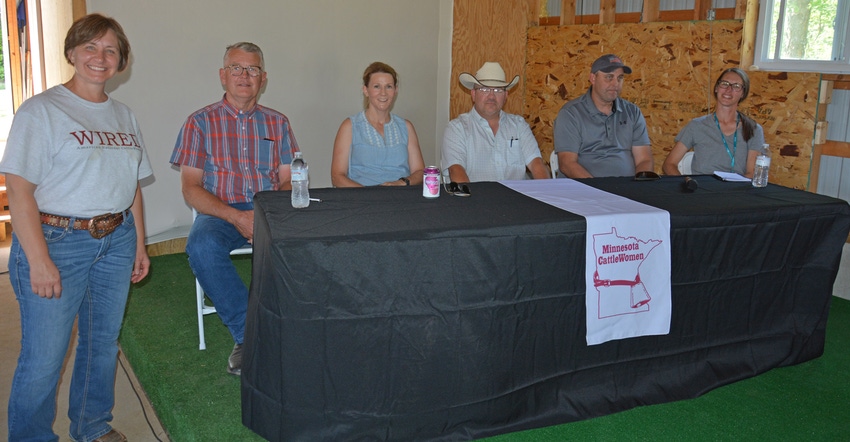
From farm to fork, each segment of the meat production and marketing chain has faced its share of challenges due to the one-two punch of the global pandemic followed by the regional drought.
Yet, each is adjusting and finding its way to continue in the beef industry. At a special event known as WIRED — Women In Ranching, Education and Development — and hosted by the Minnesota CattleWomen in Tenstrike, Minn., this summer, participants on a beef industry panel shared experiences and opinions on a range of topics
Participating on the panel were Paul Rydeen, Rydeen Farms, Clearbrook, Minn.; Jill VanDerWal, Weber VanDerWal Feedyard, Sanborn, Minn.; Mitch Barthel, Tri-County Stockyards, Perham, Minn.; Brian Schatz, president of Minnesota Association of Meat Processors, and operator of a retail slaughter plant west of Mankato, Minn.; and Jessica Heiden, Heiden Century Farms and Hart Country Meats, Rushford, Minn.. The panel was moderated by WIRED co-chair Michelle Mouser. Here is a digest of that discussion.
On choosing cattle to raise and sell. “I’ve got to have something we want to look at, plus it has to have performance,” Rydeen said. His family raises Simmental and Sim-Angus and focuses on expected progeny differences to improve genetics and improving carcass quality. All cattle in the herd are DNA-tested and have electronic ID.
As a finisher, VanDerWal has worked with a buyer for 30-some years to get weaned fall calves from Montana and North Dakota. They finish around 700 feeder calves and raise corn, soybeans and alfalfa on her family’s southwestern Minnesota farm. They like to finish cattle around 1,300 pounds. However, calves have been coming in smaller, around 350 pounds.
“We can’t get enough weight on them,” she said. She also noted cattle color influences sales.
“I’ve been told that buyers do not want white-hair cattle. Some want straight black cows,” she added. “Color matters.”
Know your market. “If you are going to sell cattle, why not talk to the guy who’s going to sell them for you?” asked Barthel, an auctioneer with Tri-County. “I need all your info. Buyers recognize tags and remember everything. We video everything, too [so a buyer can review the video if they want, due to poor-performing cattle].” Consignment forms ask for vaccinations, feed, housing, color, breed and the number of cattle for sale. He confirmed that buyers want black cattle, and that they want them big.
Reputations and relationships are made and lost based on one’s word, he added. “The biggest thing in the cattle industry is that everything stands on your word,” Barthel said. “Don’t say you’re not coming in because it’s too cold … If anyone drops the ball, then your word is no good to me.”
On the retail side, Schatz said his shop has relied on shipped boxes of National Beef’s Black Canyon Angus brand for 11 years. They do local beef and hog slaughter, too.
“We carried different commodity meats for years and started to get some complaints,” he said. “We looked at the Angus programs and tried others. National stood out for us.”
Switching gears to give a slaughter update, Schatz said that farmers need to be prepared to wait awhile for meat processing.
“There are shops booked one to two years out,” he said. Schatz added that he is excited about the new meat cutting butchering program that will be offered at Central Lakes College in Staples.
Small-herd marketing challenges. Quantity can overshadow quality at times, and small beef herd owners were encouraged to really hit on that quality attribute.
“Create value in your heifers, and make them worth what steers are,” Rydeen suggested.
Barthel circled back to his points on record keeping and animal care.
“Raise better cattle than your neighbors,” he said. “Keep better nutrition records. Vaccinate. You want your cattle to match others on sale that day [at the auction barn]. Keep them clean, with fluffy hair, and tagged.”
He also encouraged small herd producers to band together when marketing.
“Come together to sell on the same day,” he said. “Cooperative marketing work very well.”
Facing current challenges. The drought has dried up pastures and affected growing crops. Accordingly, cattle herds have been getting moved or sold. Yet the pandemic did alter consumer buying habits, in a good way.
“With livestock, you spend a lifetime building your herd. You can’t just sell it [like a crop],” Rydeen noted. He raises 400 acres of corn and, in late July, was considering chopping it for silage. They also were hauling in hay and looking at selling cows that were not pregnant.
Heiden explained that both her farm and meat market are fairly new. Her family started farming and raising Angus five years ago, and within the past year, she partnered with another farmwife to start Hart Country Meats. At Hart, located in southeast Minnesota, they handle custom processing of local beef and hogs, and sell packaged Angus meats as well as other meat, poultry and dairy foods. They rely on Dover Processing, a USDA-inspected facility, to do the processing and packaging.
“My business partner and I both have families,” she explained. They are looking ahead to future options — a meat counter? A restaurant?
“Right now, we just want to get out and promote what we are doing,” she said.
VanDerWal said their biggest challenge lately has been privately selling their own cattle to consumers. Regulations limit how many you can market, and you need a USDA-inspected plant.
Yet, she hopes the “new norm” of consumers buying local meats continues.
“I hope the new behavioral trends of wanting to cook more at home, and wanting the choice to buy a half or quarter of local beef continue,” she said.
About the Author(s)
You May Also Like






